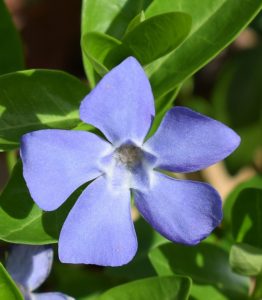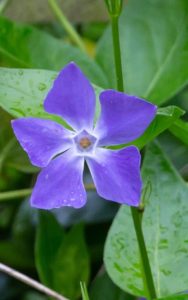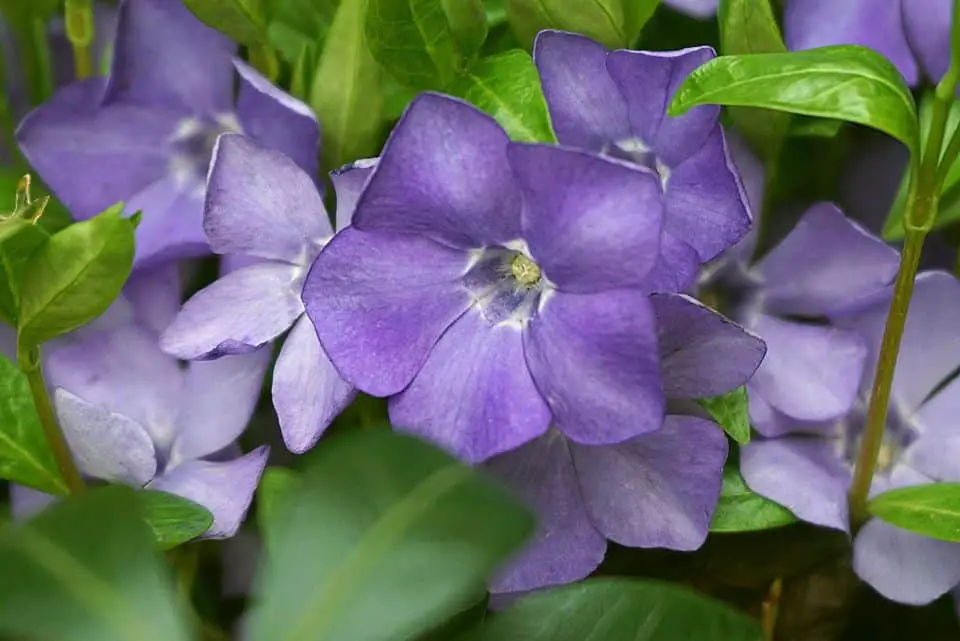Some links in the post are affiliate links and I get a commission from purchases made through some links found in the post.
Vinca vine brightens up a room if grown indoors and suits any color scheme. Vinca vine is also known as creeping myrtle and periwinkle.
It is known for its vigorous growth pattern. It is a herbaceous plant grown by many gardeners for its ground cover. Native to Asia, the Vinca vine belongs to the Apocynaceae family.
It comes in two major species Vinca Major and Vinca Minor. Vinca Major, the bigleaf periwinkle, is considered an invasive plant.
The plant is evergreen having a lean trailing stem. Although it is a vine, it can also spread over the ground quickly in a short time.
The vinca vine adds beauty indoors and outdoors by its small, delicate violet flowers through spring and summer. Sometimes the vine may also grow white blossoms. The leaves of this plant depend on the species.
The Vinca Minor has consistent green foliage, whereas Vinca Major is also known as variegated Vinca and has pattern foliage of green centers and creamy white borders beautifully, giving the appearance of brush strokes.
This vine can be grown in a garden and propagated in window baskets, hanging baskets, and planters. Being a hardy plant, it doesn’t require much care and isn’t too picky about the growth requirements.
The question you want to know is, can a vinca vine grow indoors. Yes a vinca vine can grow indoors if given the right growing conditions.
It can grow in full, partial and shade. The vinca vine is an evergreen perennial that needs loamy, sandy and clay soil with Ph ranging between 5.5-6.
Can Vinca Vine Grow Indoors?
 Vinca vine is suitable for growth both as an indoor and an outdoor plant. Many people have the vinca vine indoors near a window for its beautiful patterned foliage.
Vinca vine is suitable for growth both as an indoor and an outdoor plant. Many people have the vinca vine indoors near a window for its beautiful patterned foliage.
As it thrives well in any environmental condition, it does not require strict variables to grow and doesn’t require you to be a pro gardener.
A little care to this plant goes a long way as it is self-sustaining. It is even tolerant to difficult soils. Therefore, it can be grown in containers placed indoors.
Vinca vines can be grown outside in the summers to make blooms and kept inside during the winter and all year-round, too, if desired. It does not tolerate cold temperatures and should be moved indoors in drafts and chilly conditions.
If you want appropriate plant growth and want it to be lush, you should provide it with a similar environment to what it usually requires outside. Its need for partial sunlight makes it do well near your apartment windows.
How do you Care for a Vinca Vine Indoors?
To make your vinca vine keep its growth and variegation stable, you need to give it a little bit of care.
Apart from supplying it with a proper environment to grow, support and pruning also keeps the plant in check, prevents the overgrowth of the vines, and keeps the plant full.
Pruning keeps the spread of the plant contained and makes it have a desirable area of growth. In addition to pruning the stems, the flowers should also be pruned, known as deadheading.
It signals the plant to keep on producing more flowers. It is preferable to prune the vinca vine during the summer or spring season. Pruning during the winter makes it more vulnerable to the cold.
The plant requires watering every other week and prefers well-drained soil. The plant needs watering if the top 2 inches of soil in the container feels dry to touch.
Vinca does not need to be overflown with water. Otherwise, it would get root rot.
If you need help watering your plant, try using this automatic drip irrigation kit.
It is quite a drought-resistant plant but should not be completely forgotten about to water. If that’s the case, then its growth can retard.
Reduce watering during the winters. Your plant also needs water-soluble fertilizer once or twice a year, especially if it shows poor growth. Do not use a fertilizer with very high nitrogen content.
Since it requires partial shade to full sun, giving it a spot near a window is better. If not getting proper air circulation or sun, it may suffer from diseases like fungal infections, leaf spots, or blight.
Trim the infected stems as soon as you notice the defect to prevent the disease from spreading to the whole plant.
Watch out for the yellowing of leaves as this indicates iron deficiency common in high pH soils. It may also occur due to nitrogen deficiency.
Do not worry about the leaves curling as it is a coping mechanism in hot conditions, and the leaves will un-curl on their own when the temperature normalizes.
One thing to keep in mind is that this plant is mildly poisonous and should not be kept in any room of your apartment that has cats or other pets, as nibbling on it might affect them badly.
Can Vinca Vines be Grown in Pots?
 Vinca vines can be quite easily be grown in pots. You can either use a seed to grow a new plant that ensures better control or propagate it from a cut stem.
Vinca vines can be quite easily be grown in pots. You can either use a seed to grow a new plant that ensures better control or propagate it from a cut stem.
Choose a suitable time to grow the plant in a pot. Spring or late fall works best. A suitable pot of 8-inch width and 6-inch depth does just fine.
Using a hanging basket or a standing pot enables the plant to provide a beautiful display. The pot should have proper drainage. A few drainage holes are sufficient.
The plant grows in standard commercial potting soil. To grow the plant from a seed, germinate the seeds at around about 76 degrees Fahrenheit before planting.
Directly plant the seeds on the surface soil and cover them with a slim layer of the potting mix. Ensure adequate moisture in the soil.
Your vinca plant seedlings would emerge in 2- or 3-weeks’ time. The plant would gain a reasonable size till day 50.
If you are enjoying this article, check out our article on how to care for a naga linga tree in your house.
How to Propagate a Vinca Vine?
Propagating a new plant from stem cutting is an easy job to do. It takes a few simple steps:
1) Cut several 3- to 6-inch stems below a node from the plant using a sharp, clean knife or pruners. Always remember to sterilize the cutting tools by rubbing alcohol or Lysol.
2) Remove the leaves from the top halves of the stem. Dipping the bottom 1 inch of the cutting inside a rooting hormone increases the chances of successful rooting of the cutting.
3) Fill a pot with soil, dig a 4-inch hole in the center of the pot. It should be 4 inches wide as well. Water the soil and allow drainage.
4) Take the cutting from the parent vinca vine and place the stem cutting inside the hole at the same depth its parent plant was growing in. Pat the soil lightly around the stem.
5) Set the container in indirect sunlight, covering it with a plastic bag, and allow the cutting to grow. Even though the plastic bag keeps the soil and cutting moist, water the soil so that the top 2 inches of soil doesn’t become dry.
6) Check the cutting for roots in about one month. You can use the roots to grow into new plants. Fertilize your plant once a month, depending on the size of your container.
7) Place your new daughter vinca plant outdoors in the summer and spring for accelerated growth.
8) When growing multiple plants in the same container or pot, ensure that for when cutting a distance of more than 8 inches in between them. This spacing provides each cutting with some room to grow and spread adequately.
9) You can also divide the parent plant completely, keeping its root, node, and stem and directly plant it into another container. Ensure adequate moisture, sunlight, and temperature for growth and wait for it to gain its adult size.
What are a Vinca Vine’s Light Requirements?
Vinca vine grows well in full sun as well as in partial shade. The plant requires almost 3 to 6 hours of sun per day.
It may require one or two hours extra of sunlight during the cold winter months as the intensity of the sunlight is not as high.
The light conditions in which the vinca vine grows affects its performance. The vine’s leaves appear greener when grown in the partial sun than when grown in full sun.
The flowers, however, appear more in the sunlight. The sunlight can be altered according to your preference, whether you adore the foliage or the flowers of the vine more.
If your plant is struggling due to light, trying using this to help regulate the lighting.
Final Thoughts
 Vinca is a commonly grown ornamental plant for its evergreen foliage, spring flowers, and groundcover in gardens. Many different cultivars are available of this precious plant.
Vinca is a commonly grown ornamental plant for its evergreen foliage, spring flowers, and groundcover in gardens. Many different cultivars are available of this precious plant.
It can be easily grown indoors in pots and containers and requires very little care as it’s a hardy plant requiring full sun to partial shade.
It does not do well in winters, so it should be shifted indoors during those months. Adding Vinca indoors adds character to your apartment by its delicate violet purple leaves and gorgeous variegated leaves.
Before you go, here are some more related articles I encourage you to read below to help solve more of your gardening issues:
Best 10 House Plants for Aquaponics
Top 7 Shrubs to Plant in Front of Your House
About the Author:
Saad Ansar
Saad is an avid gardener himself and is a great lover of plants, animals, photography, & people. Currently, he is focused on photographing indoor plants & captioning beautiful outdoor sceneries. He writes and rewrites in-depth articles on nature and science.

